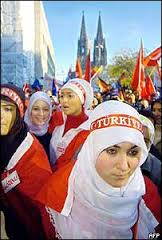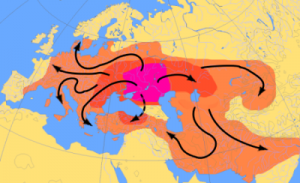
Das Sound Machine, from Pitch Perfect 2 – Photo Credit: Richard Cartwright – © 2015 Universal Studios.
I watched recently with my daughter Pitch Perfect 2, a movie about a cappella music groups who compete in an international competition in Copenhagen. The main competition to the US group (the focus of the film) is the German group (“Das Sound Machine”), who are portrayed as strange, humorless, threatening, semi-robotic, and focused on winning at any price. Not an unusual stereotype, when it comes to Germans (cf. “Sprockets” from Saturday Night Live). Another popular image is currently being played out both in Munich and in local Oktoberfests across the US (and in many other countries): happy, singing, Lederhosen and Dirndl wearing beer drinkers.
Interestingly, the images of good Germans and scary Germans are playing out in a very real arena today: the reception of thousands of migrants (probably up to a million this year) in Germany, the preferred destination of most of those fleeing Syria, as well as others from Afghanistan, northern Africa, and many other countries. In contrast to their reception in Hungary, many Germans have come out to greet the new arrivals and to provide food, supplies, and toys. Some have opened up their homes to the new arrivals. Angelika Merkel has received a lot of positive press for announcing that Syrians who make it to Germany will be granted asylum. However, now that so many are arriving daily, German officials are taking a closer look at who’s coming across their borders. They also are sending newcomers away from the Oktoberfest festivities in Munich (and away from contact with the thousands of free-spending tourists) to Nürnberg, where they will not mar the fun.
The scary Germans are the ones fire-bombing the centers for housing refugees. This has been under-reported in the press outside Germany. This summer, there have been almost daily arson attacks, particularly in the former East Germany, ironically a part of the country where there have been relatively few foreigners. This is the region that gave birth to the “PEGIDA” movement last year (Patriotic Europeans Against the Islamisation of the Occident).
If the members of that group think that the influx of vast numbers of Syrians and others will change the character of the nation, they are right. The evidence is clear: the Turkish “guest workers” (who arrived in large numbers in the 1950’s and 1960’s) and their descendants have had a significant cultural impact. Turkish-German music (mostly hip-hop), novels, and films have been phenomenally popular in Germany. Turkish words have infiltrated the German language, not to the extent that English has, but any German today will recognize words such as döner (meat cooked on a vertical rotisserie), babo (boss), lan (buddy), and many others. Just as African-American culture has enriched the US, that has been the case with Turkish-German culture as well, and is likely to play out in a similar way with Syrian-Germans.
The other benefit to Germany, of course, is the influx of warm bodies, to counter-act the declining birth rate – those young Syrian-Germans will be paying for the pensions that allow retired Bavarians to have their Mass (liter) of beer at the Oktoberfest.


